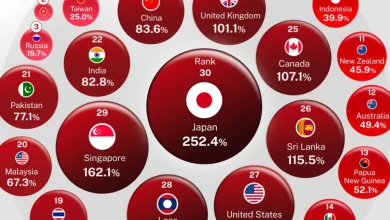The Best and Worst Personal Income Tax Rates in Europe for 2024

European nations’ personal income tax rates in 2024 vary greatly from one another. Among the most tax-friendly nations in Europe, Bulgaria distinguishes out for having a flat tax rate of 10%. Switzerland offers minimal taxes through canton-based systems, while Ireland offers beneficial tax laws, especially for corporate entities and higher earners.
However, the tax rates in Denmark and Sweden are among the highest in Europe, with high-income individuals paying up to 55%. These nations finance a wide range of social services, such as universal healthcare and education, with substantial taxation.
Europe offers a diverse range of personal income tax rates. Countries like Hungary, Estonia, and Bulgaria have some of the lowest top marginal rates, while countries like Denmark, France, and Austria have the highest. It’s important to note that these rates can vary based on factors like income level, residency status, and specific deductions and credits.
1. Which European Countries Tax Top Earners Most?
European countries with the highest taxes on top earners are:
- Sweden: With tax rates reaching up to 57%, Sweden imposes one of the highest taxes on high-income individuals to fund its extensive welfare programs.
- Denmark: Similar to Sweden, Denmark has progressive tax rates, with the top bracket approaching 55%, used to finance social services like healthcare and education.
- Belgium: Top earners in Belgium face tax rates as high as 53.7%, and the country also taxes high levels of income through social security contributions.
- France: France taxes top earners at up to 45% for incomes above a certain threshold, and it also has significant social contributions that increase the tax burden.
- Finland: Finland’s tax rate for top earners is close to 50%, and it includes both national and municipal taxes.

2. Personal Income Tax Rates in Europe 2024
Europe’s personal income tax rates in 2024 vary greatly, with some nations taxing high earnings heavily in order to finance extensive social assistance systems. Denmark (55%), Belgium (53.7%), and Sweden (57%), where taxes are combined with municipal taxes and social security contributions, have the highest tax rates. Following with the highest rates of 51.5% and 45%, respectively, are Finland and France. Other nations with high tax burdens are Germany (45%) and Netherlands (49.5%).
On the other hand, lower rates are offered by nations like Ireland (40%) and Switzerland (around 22% in some cantons), which attract high-income individuals looking for tax benefits. Because they affect disposable income and the state of the economy as a whole, these tax rates are crucial for people and businesses thinking about moving.
3.Europe’s List of Nations by Personal Income Tax Rate
The vast differences in personal income tax rates across Europe are a reflection of various social assistance programs and governmental requirements. Some of the highest rates in the world are imposed by nations like Denmark and Sweden; when local taxes are taken into account, the top rates range from 55%-57%. Numerous public services, including as universal healthcare and education, are funded by these high rates. The tax burden is far lower in Switzerland, where top rates vary by canton but are often less than 25%. Belgium and Finland are two other noteworthy nations with high tax rates (about 50%), although Ireland and the United Kingdom have somewhat lower rates (around 40%-45%). The top tax brackets in Germany and France are 42%-45% and 45%, respectively, representing middle-ground rates.
Conclusion:
Europe offers a diverse landscape of personal income tax rates, with some countries taxing top earners heavily while others maintain lower rates to attract talent and businesses. Nations like Sweden and Denmark have high tax rates that fund generous welfare systems, but they also provide strong social benefits. On the other hand, countries like Switzerland offer lower taxes but may lack some of the extensive public services seen in higher-tax nations. Overall, the tax system in each country reflects its priorities—whether focusing on wealth redistribution or encouraging economic growth through lower taxes.
FAQs:
1. Why do income tax rates vary so much across European countries?
Due to variations in political philosophies, social priorities, and economic models, income tax rates range among European nations. Progressive taxation is used by high-tax nations like Sweden and Denmark to finance comprehensive social welfare programs like healthcare, education, and pensions. Social equality and income redistribution are top priorities in these nations.
2. What are the benefits of high-income tax rates?
Strong social safety nets and free public services like healthcare and education are made possible by high tax rates in nations like Denmark and Finland.
3. Can I avoid high tax rates in high-tax European countries?
Yes, you might be able to avoid paying high taxes in European nations with high tax rates. Your tax burden can be reduced by employing techniques like tax planning, making use of credits and deductions, investigating unique tax regimes, and making the most of your residency. To guarantee compliance and optimize your tax savings, it is imperative that you seek advice from a tax expert.



